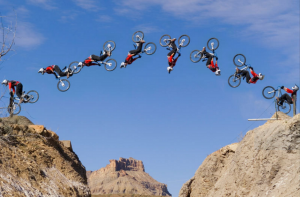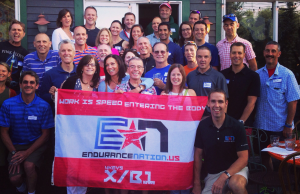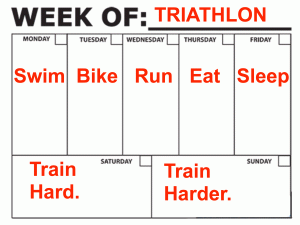Written by Patrick McCrann, Endurance Nation founder and 22-time IRONMAN finisher Whether you’re new to triathlon, or a seasoned veteran, you fully understand the true cost of our sport: time and money. As the sport of triathlon has evolved over the past 20 years, it has gotten increasingly more complex and specialized.
Whether you’re new to triathlon, or a seasoned veteran, you fully understand the true cost of our sport: time and money. As the sport of triathlon has evolved over the past 20 years, it has gotten increasingly more complex and specialized.
While it might seem like everyone on race day takes triathlon very seriously, that’s not a prerequisite for success. In this article were are going to explain to you five critical areas that you can focus on to maximize your training time and retain your triathlon dollar.
As a beginner, when you go to a race it is probably difficult to figure out who is doing this for fun and who is doing this professionally.
As background, Endurance Nation has been around for over a decade. We’ve had more than 1,000 Ironman® finishes a year, every year, since 2010. We are the Ironman® Division I World Champions for three years in a row.
Translation — we have worked with countless athletes to help them refine the training schedules and improve the results within the framework of their existing lives. This is no small task, but we learned quite a few things along the way which I want to share with you.
 Tip Number One: You Don’t Need A Triathlon Coach
Tip Number One: You Don’t Need A Triathlon Coach
Remember the thing we said before about complexity? Introducing a coach into your system dramatically increases the complexity of your triathlon experience. The coach is going to have a bias around how you want to train. Your coach is going to introduce many different types of workouts that require you to change your schedule frequently.
You become dependent upon a coach for those workouts. Will they be here on time? Are they different than last week? Is Coach going to answer my email? My text? We have consistently found that the most successful triathletes are also the most self-sufficient. Do yourself a favor and start things off on the right foot by taking charge of your training and racing.
Tip Number Two: Get Social
Humans are incredibly social creatures and triathlon is no exception. We are very adept at following the lead of others – from clothing to training to cars to dogs…you get the idea.
Do yourself a favor and find a local triathlon club. This will be a great place for you to learn a ton about the sport and to stay connected with others as you progress down the experience road. This group will have workouts, social events, learning events, and so on. They might even have discounts available at local stores, or can recommend you to local professionals if you need help in a certain area (injury anyone?).
Just as importantly, training with others will help keep you motivated and hold you accountable. It’s really hard to snooze the alarm when you know there could be ten people waiting for you at the pool that morning. Think of a social group as using a carrot to motivate you, where is hiring a coach is more like using a stick.
Tip Number Three: Build A Basic Week
Back in the day, there were very few resources on triathlon training. It was honestly hard to find out how to prepare. Today there are millions of articles countless resources and very little of it is coherent or makes sense. So where should you begin?
The most important thing that you could do as a triathlete is to define a week of training that works with your schedule. It might be fantastic to swim one hour before you get on the bike for a three-hour ride. But if that workout doesn’t fit into your life without causing major friction — it’s just not worth it.
Getting in your training in is a constant balance – not battle – between what you want to do and what you need to do. If you start out by making the training fit, then you have effectively eliminated that friction.
You can do this by sitting down and taking a look at your week. Where can you carve out approximately an hour a day to do your training. For many of us, the early morning is the easiest time to do this before work.
Life has a way of getting away by the end of the day between extra work, meetings, traffic, kids, activities, and so on. Stack the deck in your favor by focusing on an earlier bedtime with an earlier wake time to get those sessions done before the world wakes up and gets crazy.
In the same way, we recommend you structure your bigger training sessions on the weekends when there is more time. If you have a long-run in the program or a long ride- put those on Saturday and Sunday. It doesn’t matter which one goes on which day — both options are better than trying to squeeze those sessions into your existing Monday through Friday schedule.
Most Age Group triathletes create time for training by reducing their sleep. This is a critical mistake that can lead to undue fatigue, and even injury or illness. Do your best to stay as close to 42 to 45 hours of sleep a week.
Our final training tip for you is to make sure that you have at least one day of rest the week. For most triathletes, this is the hardest session to schedule. If I’m not working out – I must be going backwards – is the usual train of thought.
This couldn’t be further from the truth. Every workout, even every week, requires a window of recovery. During this time your body is processing the work that you’ve done and giving you space to get stronger.
For example, if we just did a massive squat workout at the gym with tons of weight, chances are you and I are exhausted. When we walk out of the gym (or stumble!), we are probably the weakest two people within a 250-mile radius! Give us a day to recover and we’ll come back stronger.
Don’t allow for recovery? All of your workouts for the remainder of that week will suffer… so plan accordingly. 
Tip Number Four: Get Smarter To Go Faster
Inside Endurance Nation we spend the vast majority of our time creating resources and opportunities for athletes to learn. It’s not a mistake that the fastest athletes you know are also some of the smartest. Not necessarily book smart, but they know their body, they know their limits, and they figure out a way to make the most of what they have.
As a beginner, this is an incredible area for you to grow. So do yourself a favor and spend some of your time in the evening trying to learn more about how you can improve. There are three distinct ways that you can do this:
- Get Your Lead On: It’s very easy to fire up your smart phone and find hundreds, if not thousands, of articles on travel and training. Be specific in your search terms or pay attention to the authors’ names. Odds are you’ll find a common thread and what you like to read and can find more articles from the same source over time.
- Find key, online resources: There are a few key websites that cover triathlon 24-7, these are good places to start as well. I don’t recommend buying a book as most of those are quickly outdated…and are ultimately more complex than the bite-size information that you probably need (and are actually able to absorb).
- Watch and Learn: Head over to YouTube or simply search for videos on triathlon. There are plenty of great examples of things to do – and not to do! – When it comes to triathlon. You can find videos on swim technique, cycling skills, running technique, and more.
If you’re looking for a good laugh there are probably some great “triathlon fail” videos out there of people making mistakes. You will learn a great deal by watching the folks that you train with, which you can continue that learning curve online using your computer.
Tune into Triathlon: There are many many triathlon podcasts available now thanks to a growing market and portable technology. Get on your phone and find a few of the podcasts you’re interested in so you continue to learn. Podcasts are great because you can listen to them while you’re doing something else. You can listen to them in the car, when you’re commuting, even when you’re running.
These are nice ways of complementing experience and don’t actually take away from the other things you are doing in the moment. Plus, there are some great interviews as well as plenty of of stories and anecdotes to make you laugh. 
Tip Number Five: If It’s Not Fun, Why Do It?
At the end of the day, triathlon is meant to be a hobby. The minute it feels like a job, the less likely you are to want to do it. This is partly while having a training group is an excellent means of getting faster because it’s fun, you want to go, and they will challenge you.
But starting to put yourself in a silo, or putting external pressures on yourself to perform…odds are you are going to ruin your fledgling triathlon experience.
You can keep triathlon fun by picking lots of other races you can do along the way. Any local 5K or 10K run will do. The first charity bike ride in your town, go sign up for it. You are a triathlete, you can do it! While open water swim events are hard to find, if you’re fortunate enough to live near a good body of water, chances are there are some some groups who will be better and you can join.
Take on new experiences. Search for new running routes or cycling. Get outside of your comfort zone and use triathlon as a means to explore, not only your fitness and potential, but your neighborhood too.
It’s important to keep triathlon fun because the longer you play the game, the better you get at the game.
Bonus Tips!
We hope you enjoyed these five basic ideas for how you can improve your triathlon training for fun — and maximum results. But as athletes move down the spectrum of experience, they begin to look for other ways to get faster, stronger, and better. Here are a few bonus tips for those of you looking to go the extra mile.
Bonus Tip Number One: Get Fitter By Using Intensity, Not Time, To Your Advantage
Inside Endurance Nation we use a fixed training schedule so that every week you know that your Thursday workout is an hour. We make every Thursday — each week — incrementally harder by changing the intensity of the main set so you are doing more work.
So instead of having a 60-minute workout this week, a 70-minute workout next week, and an 80-minute workout the following week – you always train for an hour. Not only can you create a positive training stimulus, you are doing so without adding extra time which might interfere with your basic life or sleep patterns.
Tip Number Two: Stack Your Workouts To Save Time
If you have a bike and run workout – commonly known as a “brick” workout for the way your legs feel when you try to run — try to put them together. Any time that we can combine two workouts into one training session is more efficient for your schedule.
Two workouts, typically means two showers- which is often a deal breaker. Combining two workouts into one, can make just one shower and freeing up a bit of time. Do yourself a favor see how well you can bundle things together to reduce the impact on your daily life. As for Tip number three: keep a training diary…
Tip Number Three: Past Performance Is the Best Predictor of Future Performance
Nowadays with electronic trading gadgets and online logs, you have very little to no excuse for not tracking your workouts. However, it doesn’t have to just be the data. For example, you can talk about how you feel or what sessions you enjoy that week. However you choose to record it, I encourage you to do it.
Often times being able to go back and look at your training is a great way to discover how you ended up injured. Or how you got sick. Or, what worked last time you went so fast. But without the personal history, you will never know and overall improvement will suffer.
Tip Number Four: Take on Additional Resources
Endurance Nation has a compilation of articles, podcasts, and videos designed to help triathletes regardless of the specific area that they are interested in. We’ve created several key pages on our website where we have aggregated this information to help make your life easier.
If you are interested in learning more about any of the topics covered here, feel free to visit us online: www.endurancenation.us. As the online home of a triathlon, Endurance Nation is here to help you improve and tackle your next endurance challenge. Come on over to browse our website, and see if we can help you out.
Interested in getting a 30 day, free trial of Endurance Nation to take it out for a “test ride” befor you make any obligations?
About the Author: Endurance Nation founder Patrick McCrann is a 22-time IRONMAN finisher with seven trips to Hawaii. He lives in Rhode Island with his family where he enjoys trying to fit the swim, the bike and the run in between all of the soccer practices, dance recitals, and after school activities that make life fun.
Save



